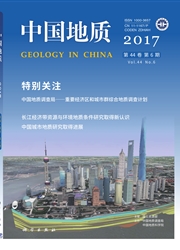

 中文摘要:
中文摘要:
通过对川东南地区野外露头、大量岩心、测井等资料的综合研究结果表明,研究区早志留世晚期发育2个沉积体系组,包括3种沉积相及众多亚相、微相类型。其中三角洲沉积主要发育于靠近江南—雪峰山隆起的川东南—湘西地区;碳酸盐岩台地沉积主要发育于川南—黔北地区;陆棚沉积主要发育于宜宾—重庆一带。沉积模式显示了早志留世晚期川东南地区为受古隆起控制的局限海盆,研究区东部发育一套以碎屑岩为主的小河坝组,由于江南—雪峰山不断隆起,向研究区提供了大量物源,沉积了一套向上变粗的三角洲沉积。研究区南部受黔中隆起控制,由于黔中隆起相对稳定,在其北侧主要发育了与小河坝组同时异相的石牛栏组碳酸盐岩台地沉积。该新认识有助于了解川东南地区小河坝组砂体的时空展布,以及预测该区有利油气聚集区带。对下一步油气勘探部署具有重要的理论意义和实际指导价值。
 英文摘要:
英文摘要:
In order to determine sedimentary characteristics and model of the Late Early Silurian strata,the authors comprehensively studied outcrop sedimentary features and a large number of core and well logging data of the Silurian Xiaoheba Formation.The results show that the late Early Silurian transitional sedimentary system group and marine sedimentary system group are developed in southeastern Sichuan Province and include three kinds of sedimentary facies and lots of sub-facies as well as micro-facies.Delta deposits are developed in southeast Sichuan-western Hunan area close to Xuefeng Mountain uplift.Carbonate platform deposits are developed in southern Sichuan-northern Guizhou area.Shelf deposits are developed in the Yibin-Chongqing area.Sedimentary model shows that southeastern Sichuan area was a confined basin in early Silurian Xiaoheba period controlled by the uplift.In the east,controlled by Jiangnan-Xuefeng Mountain uplift,there exist a set of upward coarsening delta deposits.In the south,controlled by the relatively stable Guizhou uplift,carbonate platform deposits are existent on the northern side.The new understanding has an important theoretical and practical significance for more accurately predicting the distribution of the sandstone of Xiaoheba Formation in southeastern Sichuan Province,forecasting favorable accumulation zones and further deploying oil and gas exploration.
 同期刊论文项目
同期刊论文项目
 同项目期刊论文
同项目期刊论文
 期刊信息
期刊信息
